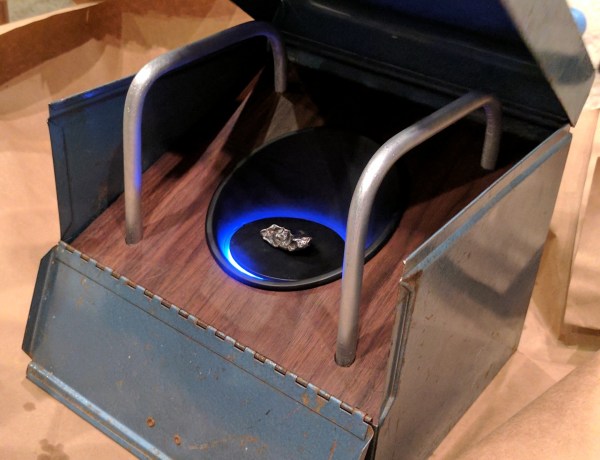We’re always a wee bit suspicious about articles that announce some sort of “World’s first” accomplishment. With a couple of hundred thousand years of history, most of which wasn’t recorded, over which something like 117 billion humans have lived, any claims of primacy have to be taken with a grain of salt. So when the story of the world’s first instance of a car being hit by a meteorite came across our feed, we had to check it out. The car in question, a Tesla, was being driven in South Australia by veterinarian Andrew Melville-Smith when something suddenly crashed into its windshield.
meteorite6 Articles
Casting Meteorite-like Materials
From the outside, iron meteorites tend to look like formless, rusted lumps of metal, which is why museums often polish and etch sections to show their interior structure. This reveals their Widmanstätten patterns, a latticework structure of parallel iron-nickel intermetallic crystals which forms over millions of years of very slow solidification. Inspired by this, [Electron Impressions] created his own metal composition which forms similar patterns on a much-faster-than-geological time scale.
Witmanstätten patterns form when a meteorite colliding with a planet launches molten iron and nickel into space, where they very slowly solidify. As the mixture cools, it first forms a stable phase called Taenite, then begins to precipitate another phase called Kamacite. Kamacite forms needle-shaped crystals, which when polished show up against the Taenite background. However, such needle-shaped growth only becomes noticeable at a cooling rate of a few degrees per million years, so it’s not really a practical way to make the pattern. Continue reading “Casting Meteorite-like Materials”
Hackaday Links: January 19, 2025
This week, we witnessed a couple of space oopsies as both Starship and New Glenn suffered in-flight mishaps on the same day. SpaceX’s Starship was the more spectacular, with the upper stage of the seventh test flight of the full stack experiencing a “rapid unscheduled disassembly” thanks to a fire developing in the aft section of the stage somewhere over the Turks and Caicos islands, about eight and a half minutes after takeoff from Boca Chica. The good news is that the RUD happened after first-stage separation, and that the Super Heavy booster was not only able to safely return to the pad but also made another successful “chopsticks” landing on the tower. Sorry, that’s just never going to get old.
On the Bezos side of the billionaire rocket club, the maiden flight of Blue Origin’s New Glenn ended with the opposite problem. The upper stage reached orbit, but the reusable booster didn’t make it back to the landing barge parked off the Bahamas. What exactly happened isn’t clear yet, but judging by the telemetry the booster was coming in mighty fast, which may indicate that the engines didn’t restart fully and the thing just broke up when it got into the denser part of the atmosphere.
Fantastic Micrometeorites And Where To Find Them
Space is very much the final frontier for humanity, at least as far as our current understanding of the universe takes us. Only a handful of countries and corporations on Earth have the hardware to readily get there, and even fewer are capable of reaching orbit. For these reasons, working in this field can seem out of reach for many. Nevertheless, there’s plenty about the great expanse beyond our atmosphere that can be studied by the dedicated citizen scientist. With the right equipment and know-how, it’s even possible to capture and study micrometeorites yourself!

For those new to the field, the terms used can be confusing. Meteoroids are small metallic or rocky objects found in outer space, up to around 1 meter in size. When these burn up upon entering the atmosphere, they are referred to as a meteor, or colloquially known as a shooting star. If part of the object survives long enough to hit the ground, this is referred to as a meteorite, and as you’d expect the smaller ones are called micrometeorites, being on the scale of 2mm or less.
Stardust Proves Hard To Find
Being tiny and having fallen from space, micrometeorites present certain challenges to those who wish to find and identify them. In spite of this, they can be found by using the right techniques and a heck of a lot of hard work.
Continue reading “Fantastic Micrometeorites And Where To Find Them”
A Meteorite Gift Box
[Justin Cole] was looking for the perfect birthday gift from for his wife. After some pondering, the answer fell from the sky in the form of a meteorite. The problem was how to present it. They don’t exactly make meteorite gift boxes, so [Justin] decided to build one of his own design. The box has a Russian space age theme reflecting the meteorite’s country of origin. The theme also made it a perfect entry for Hackaday’s Sci-Fi contest.
The gift box started life as an old steel film reel box. Some of us may still have boxes like this in our basements, protecting old 8mm family movies. [Justin] modeled the box in Solidworks, then added in his custom modifications. An angled walnut platform forms the stage. In the center of the stage is a 3D printed cone. The meteorite itself sits on a platform in the middle of the cone. A magnet keeps the iron meteorite in place.
A Neopixel ring provides indirect lighting below the meteorite. The ring is controlled by an Arduino, which also drives a couple of vibration motors. The motors create a hum in time to the changing colors of the ring. The whole package creates a neat way to present a rock from space.
We really like that [Justin] didn’t go over the top with sound effects, smoke, or bright lights. More importantly, [Justin’s] wife loved it, and couldn’t wait to share a video of the box with her friends.
It’s not to late to get in on the Hackaday Sci-Fi contest action. You have until Monday evening to enter your own creation.
Fripon Is French For Meteorite Hunting
Just a few weeks ago, we reported on a US NASA project to track the path and estimate the size of meteoroids in the sky using a distributed network of a handful of cameras. It turns out that there’s a similar French effort, and it’s even cooler: the Fireball Recovery and InterPlanetary Observation Network (FRIPON). (The name is cute, if the acronym is contrived: a “fripon” is a trickster in French.)















